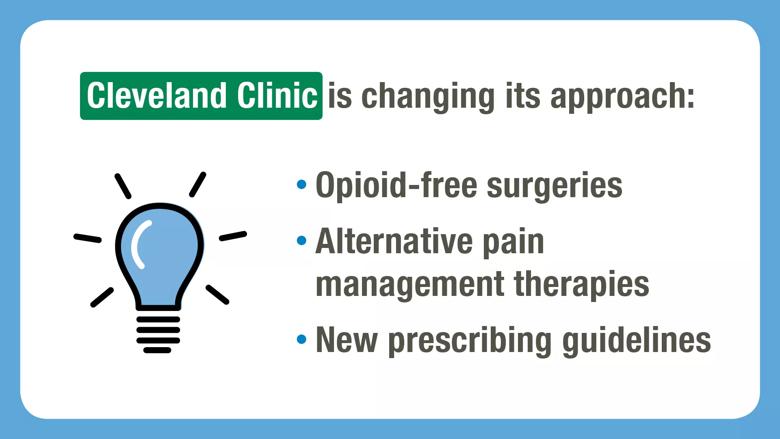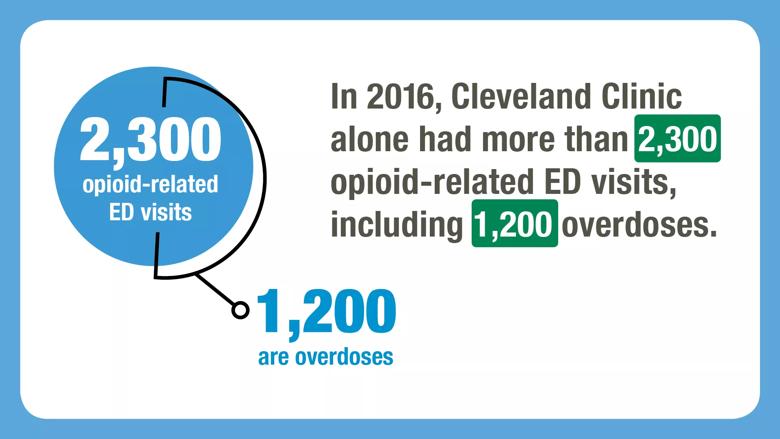Cleveland Clinic News Service | 216.444.0141
We’re available to shoot custom interviews & b-roll for media outlets upon request.
CCNS health and medical content is consumer-friendly, professional broadcast quality (available in HD), and available to media outlets each day.
images: 0
video: 0
audio: 0
text: 0

It’s an unfortunate reality that Ohio leads the nation in opioid-related emergency room visits. In 2016, Cleveland Clinic alone had more than 2,300 opioid-related ED visits, including 1,200 overdoses. It’s important to note that healthcare bears some responsibility. Over 75% of opioid addictions begin with a prescription. We’re committed to alternative ways to treat pain.
Read Dr. Cosgrove’s op-ed: Healthcare Providers Helped Bring About the Opioid Epidemic; Now It’s Time to End It


Getting Back on TREK
Back pain strikes about 31 million Americans at some point during their lives. All too often, the first-line treatment is surgery or pain killers. At Cleveland Clinic, we are offering a different approach. Back on TREK (Transform Restore Empower Knowledge) is a pilot program treating patients with chronic low back pain (with or without leg pain), with the goal of restoring function through non-surgical treatment approaches and providing patients with tools to manage their pain without opioids.
The program utilizes a combined treatment approach of psychologically informed physical therapy; pain neuroscience education and behavioral medicine sessions utilizing cognitive behavioral therapy and psychological education techniques. More than 60 percent of patients showed significant improvement in pain and disability; over half demonstrated significant reduction in fatigue, pain interference, and overall physical health.
Addiction during pregnancy
Half of all pregnancies in the United States are unintended. Many women who find themselves unexpectedly pregnant suffer from substance disorders. The Cleveland Clinic has seen an increase of women year over year with substance disorders. We have launched an opioid use disorder team where general OB’s, maternal fetal medicine OB’s, midwives, nurses and social workers are all trained to identify these women. They help with withdrawal management and support them throughout pregnancy. Our goal is to screen all patients, find those at high risk and get them into a medication-assisted treatment program during pregnancy to co-manage them during pregnancy and continue to guide them postpartum.

Painless mastectomy
This is an experimental medication we are studying. It’s local anesthesia medicine released over time after mastectomy followed by breast reconstruction to help patients with the worst of the pain—within the first four days post-surgery—so patients don’t rely on pain medicine to get through that period. It’s a long-lasting drug that is encased in a liposome and slowly released. The medicine provides pain control and potentially enables faster recovery while reducing opioid use.
Opioid-free colorectal surgery
We treated about 80 patients undergoing colorectal cancer surgery in 2016 at Cleveland Clinic Akron General. In 1/3 of the cases, no opioids were used. Beyond reducing use of opioids, the other benefits include lower risk of complications, shorter hospital stays (by about 50%), decreased surgical costs and lower readmission rates. After this surgery, patients are leaving the hospital in an average of 2.3 days compared to 2.7 days previously.
ERAS (Enhanced Recovery After Surgery)
Recently, comprehensive research has indicated that an ERAS methodology that permits patients to eat before surgery, limits opioids by prescribing alternate medications and encourages regular walking reduces complication rates and accelerates recovery after surgery. ERAS can reduce blood clots, nausea, infection, muscle atrophy, hospital stay and more. Patients are also given a post-operative nutrition plan to accelerate recovery, and physicians are using multi-modal analgesia, limiting the use of opioids. The Cleveland Clinic and other health centers are using this program.

Related links from our Health Essentials blog:
Cleveland Clinic is a nonprofit multispecialty academic medical center that integrates clinical and hospital care with research and education. Located in Cleveland, Ohio, it was founded in 1921 by four renowned physicians with a vision of providing outstanding patient care based upon the principles of cooperation, compassion and innovation. Cleveland Clinic has pioneered many medical breakthroughs, including coronary artery bypass surgery and the first face transplant in the United States. Cleveland Clinic is consistently recognized in the U.S. and throughout the world for its expertise and care. Among Cleveland Clinic’s 82,600 employees worldwide are more than 5,786 salaried physicians and researchers, and 20,700 registered nurses and advanced practice providers, representing 140 medical specialties and subspecialties. Cleveland Clinic is a 6,728-bed health system that includes a 173-acre main campus near downtown Cleveland, 23 hospitals, 280 outpatient facilities, including locations in northeast Ohio; Florida; Las Vegas, Nevada; Toronto, Canada; Abu Dhabi, UAE; and London, England. In 2024, there were 15.7 million outpatient encounters, 333,000 hospital admissions and observations, and 320,000 surgeries and procedures throughout Cleveland Clinic’s health system. Patients came for treatment from every state and 112 countries. Visit us at clevelandclinic.org. Follow us at x.com/CleClinicNews. News and resources are available at newsroom.clevelandclinic.org.
Editor’s Note: Cleveland Clinic News Service is available to provide broadcast-quality interviews and B-roll upon request.